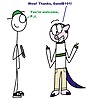HOME | DD
 Eurwentala — A Wonder of Nature
Eurwentala — A Wonder of Nature

#anatomy #biology #illustration #mollusk #science #snail #textbook
Published: 2018-08-15 11:53:37 +0000 UTC; Views: 4891; Favourites: 186; Downloads: 0
Redirect to original
Description
Small and humble, but wonderfully complex - that's my main impression about snails. These small mollusks have an extremely specialized, asymmetrical, spiral-shaped internal anatomy and a huge hermaphroditic reproductive system. They shoot each other with calcified 'love darts' during their slow, deliberate, and oddly complex mating rituals. They have eyes at the end of telescopic stalks. They eat with a muscular rasping tongue covered with tiny 'teeth'. What's not to love?
This is another one of the illustrations for a series of biology textbooks published by the Finnish National Agency for Education. The books are aimed for students who need extra support, such as those with learning difficulties, or immigrants still learning the language. So, the main focus of illustrations was to make them as clear and easily understood as possible, sometimes even if that meant a slight clash with factual accuracy. An interesting challenge!
The anatomy illustrations were all paired by a photo of the same animal in the exact same position to make it easier for the students to see what the structures look on the outside. The model for this one was a snail I collected from a park nearby. The exact species might be Helicigona lapicida.
Related content
Comments: 48

Here is a poem for you:
"I have a pet snail,
his name is Baxter.
I DIDN'T EVEN KNOW ABOUT HIS ANATOMY
UNTIL I SAW THIS BASTARD!"
👍: 0 ⏩: 1

Thanks for the poem. 
👍: 0 ⏩: 1

no problem! It's actually really intriguing to know that such complexity could be within something so small.
👍: 0 ⏩: 0

Vine snails - helix pomatia can make some noises. Like blowing bubles. I guess, they don't know it. But maybe it is of some use. Or maybe it is just side effect of breathing (they do throught the hole behind the shell).
👍: 0 ⏩: 1

That's interesting! I have never heard them make noises, but I have only seen them a few times. They're pretty rare in Finland.
👍: 0 ⏩: 1

It's sounds like opening wet lips. Probably it's just side effect of breathing and not an intended noises.
👍: 0 ⏩: 0

They could be smarter than they looks. In the garden I took vine snail and then placed back. He probably didn't liked it. After a day it disapeared from garden and is not seen. I tought it was slow. But night was enought to get from there.
Alsou some snails can use their shells to attack predatory beatles. With lack of speed they should have some secret ways of survival.
👍: 0 ⏩: 0

I have nothing personal against Gastropoda, but the fact that each species is classified in multiple clades just irks me off.
👍: 0 ⏩: 1

Take, for example, Cornu aspersum, the garden snail. It is classified under five clades simultaneously. For a worldbuilder like me trying to select a mass extinction casualty list, this is just too much, so I decided to eliminate Gastropoda entirely in my alternate Earth's first extinction event and get it over with.
👍: 0 ⏩: 1

Oh, I took a look at Wikipedia and see what you mean now. But all other taxa are classified under piles of unranked clades too. They are just not usually listed that way.
👍: 0 ⏩: 1

Yeah - that's the problem with trying to use Linnaean taxonomy in a world where evolution happens. When you think of a family tree - a phylogeny - of organisms, there can be any number of branches. However, the Linnaean system only allows us to give ranked clades to a set number of them (species, genus, family, order...). Some can be added (infraorders, subfamilies etc.), but it's still hopelessly inadequate. So, in modern systems, there are always piles of unranked clades in addition to the traditionally ranked ones.
Maybe it's easier to grasp with a familiar animal. Say, a raven. It belongs into a genus (Corvus), a subfamily (Corvinae), and a family (Corvidae), but after that it gets complicated. A raven is simultaneously classified under all these clades, each fitting within the next:
Corvioidea
Corvides (infraorder)
Passeri (suborder)
Passeriformes (order)
Passerimorpha
Psittacopasserae
Eufalconimorphae
Australaves
Telluraves
Inopinaves
Neoaves (superorder)
Neognathae (infraclass)
Aves (class)
Ornithurae
Ornithuromorpha
Euornithes
Ornithothoraces
Avialae
Averaptora
Eumaniraptora
Paraves
Pennaraptora
Maniraptora
Maniraptoriformes
Coelurosauria
Avetheropoda
Tetanurae
Averostra
Neotheropoda
Theropoda (suborder)
And so on: we could go back all the way to the domain Archaea. But even within this small set, we managed to classify the raven under 23 unranked clades (and in two suborders at the same time, highlighting the problems of the Linnaean system). Five for the garden snail seems fairly manageable, right?
👍: 0 ⏩: 0

I have had snails as pets before! They are just so cute! 
👍: 0 ⏩: 0

I had no idea snails where hermephradites...
I also didn't know their genitals where located on their heads...
You learn something new everyday!
👍: 0 ⏩: 1

Yeah! Most terrestrial gastropods are hermaphrodites! However, many of the aquatic snails and slugs actually have separate genders, evolution works in crazy ways sometimes, huh?
👍: 0 ⏩: 0

This is both intriguing and fascinating. Coming from a person who draws snails from time to time. Impressive work. 👍👍🐌
👍: 0 ⏩: 0

I had a Brehm book in the library when I was like 8 or 10. It had images just like this. You made me feel a kid again - curiosity - Thank you!
👍: 0 ⏩: 0

Next time a creationist says animals have uniformity of structure, or tha tales and females evolved separately, show them this.
👍: 0 ⏩: 0

Great work, I've always loved snails and slugs! Most amazing slug I've ever seen was big, banana-yellow, and with holes in its side (spiracles or pneumostomes likely) into which you could see right inside it at the spongy kind of lung tissue!
👍: 0 ⏩: 0

The genital opening is right at the back of it's head, so perhaps at the border between the head and the foot would be right. Weird things, in any case. You can see the location fairly well in this photo: en.wikipedia.org/wiki/Mating_o…
👍: 0 ⏩: 0

Could you call it a literal dickhead?
👍: 0 ⏩: 1

Yeah, starfish are also hemaphroditic...
👍: 0 ⏩: 1

What's hemaphroditic mean?
👍: 0 ⏩: 1

It means having both male and female sex organs, snails and starfish are a good example!
👍: 0 ⏩: 1

Yeah, life is strange...
👍: 0 ⏩: 0

Snails are such odd fellows, especially with the whole "love dart" thing. It's very nice that you're making these, I really don't know much about anatomy outside of mammals, so this is very helpful!
👍: 0 ⏩: 1

Thanks! When you get used to vertebrate anatomy, there's an endless treasure trove of weirdness in invertebrates. Ears on their legs, penises on their heads, ring-shaped brains circling their throat, everything.
👍: 0 ⏩: 2

Oh, and which invertebrates are you describing?
👍: 0 ⏩: 1

Those would have been grasshoppers, snails, and octopuses. Basically, the octopus throat is inside their brain. And all of the arms have their separate little brains and seem to be semi-autonomous.
👍: 0 ⏩: 1

As for vertebrates, turtles urinating from their mouths, prehistoric bovids with bony nasal chambers, ducks with penises twice their size (and deceptive vaginas to combat this), albatrosses with salt glands in their eyebrows, leatherback sea turtles with spiky throats, prehistoric monitors with 4 eyes, cave salamanders with no digestive tracts, sauropod dinosaurs with spines on their cervical vertebrae, gulpers resorbing their skeletons and teeth to produce calcium for their eggs, and male anglerfish basically being parasitic testicles.
Well, it's kinda clear who wins here...
Damned invertebrates.
👍: 0 ⏩: 1

How does it live without a digestive tract? How can it eat?
👍: 0 ⏩: 1

Well, they'll resorb it when food is scarce...
👍: 0 ⏩: 0

interesting, i always thought the shell was more hollow so that the snail could slip into it
👍: 0 ⏩: 1

Yeah, it looks surprisingly full of stuff when illustrated this way. Then again, mollusks are masters at fitting into things they certainly should not fit.
👍: 0 ⏩: 2

Oh lord, octopuses are pretty much the definitive mollusks...
Being able to squeeze through holes the size of a quarter (22 mm) is the most amazing thing about these guys to me.
👍: 0 ⏩: 0

that's the upside to having no skeleton
👍: 0 ⏩: 1

Think of all the things you could do...
👍: 0 ⏩: 1

i could slip under my little brothers bedroom door at night and scare the shit out of him
👍: 0 ⏩: 1

i couldn't think of any other thing to do sorry
👍: 0 ⏩: 0

Now I really want to see a shell less snail.
👍: 0 ⏩: 0






















